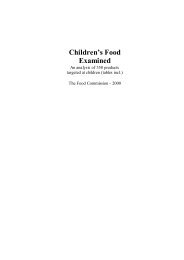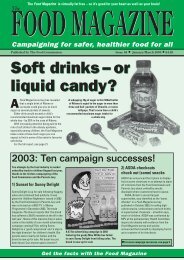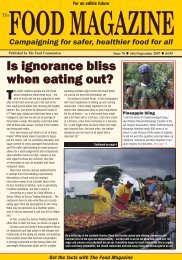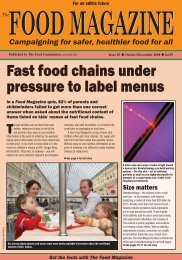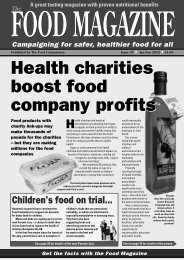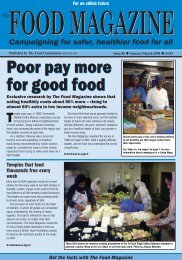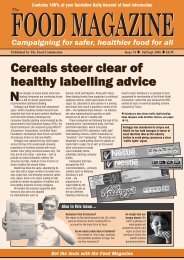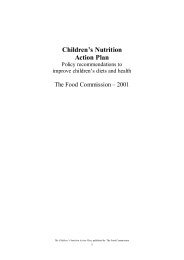Campaigning for safer, healthier food for all - The Food Commission
Campaigning for safer, healthier food for all - The Food Commission
Campaigning for safer, healthier food for all - The Food Commission
You also want an ePaper? Increase the reach of your titles
YUMPU automatically turns print PDFs into web optimized ePapers that Google loves.
<strong>food</strong> safety<br />
Climate change: the<br />
risk of <strong>food</strong> poisoning<br />
Among the many problems<br />
that climate change may bring<br />
to the British Isles is a rise in<br />
the risk of <strong>food</strong> poisoning,<br />
especi<strong>all</strong>y during the winter<br />
months. Tim Lobstein reports<br />
With alarming regularity, the media tells<br />
us of the likely rise in temperatures<br />
we will face over the coming century<br />
if action is not taken to curb greenhouse gas<br />
emissions. In April, the government’s Chief<br />
Scientific Officer Sir David King projected a likely<br />
rise in global temperature of at least 3°C. But<br />
what effect will this have on <strong>food</strong> safety?<br />
Prevailing climate has a significant effect on<br />
the risk of getting <strong>food</strong> poisoning. Currently, the<br />
number of <strong>food</strong> poisoning cases increases in<br />
summer and decreases in winter, and there is a<br />
correlation between prevailing temperatures and<br />
reported <strong>food</strong> poisoning incidence.<br />
A 1995 study by Bentham and Lang<strong>for</strong>d<br />
showed that above a threshold of around 7.5°C<br />
the rate of <strong>food</strong> poisoning rises strongly with the<br />
prevailing temperature (see ref 1 in box, right).<br />
On this basis the authors estimated <strong>food</strong><br />
poisoning incidence if global temperatures were<br />
to rise. On the basis of a 2°C rise, the figures<br />
suggest that <strong>food</strong> poisoning incidence could<br />
increase by as much as 20%.<br />
In the UK the highest increase in incidence<br />
may occur <strong>for</strong> the period from autumn though to<br />
spring, when global warming will increasingly<br />
raise the prevailing temperature above the 7.5°C<br />
threshold (this is illustrated in the graph, based<br />
on prevailing temperatures in East Kilbride,<br />
Scotland). If temperatures rise by 4°C then the<br />
figures <strong>for</strong> winter months leap again.<br />
A contributing factor may be an increase in<br />
the fly and blowfly populations, which typic<strong>all</strong>y<br />
breed at temperatures above 10°C. Larvae can<br />
develop at temperatures as low as 3.5°C. <strong>The</strong><br />
result of milder winters could mean greater<br />
problems of <strong>food</strong> contamination with insectmediated<br />
enterobacteria and enteroviruses.<br />
Day-night temperature changes may also be<br />
important. Milder night-time temperatures can<br />
increase the proliferation of micro-organisms in<br />
<strong>food</strong> left in ambient temperature, and increase<br />
the numbers of insects that transmit disease.<br />
Warming seas may mean that some<br />
biotoxins associated with warmer weathers,<br />
such as the fish-borne toxin that causes<br />
Ciguatera sickness, may extend their range to<br />
higher latitudes, raising the risk of poisoning <strong>for</strong><br />
people eating fish and shellfish.<br />
<strong>The</strong>re may also be an increase in the<br />
occurrence of toxic algal blooms which have<br />
complex relationships with human poisoning and<br />
are ecologic<strong>all</strong>y and economic<strong>all</strong>y damaging.<br />
Increased humidity can encourage fungal<br />
growth, raising the risk of fungal-based contamination<br />
of <strong>food</strong> (e.g. with ochratoxin and aflatoxin).<br />
Further, periods of drought encourage mice and<br />
rats to seek sources of <strong>food</strong> in human houses,<br />
which raises the risk of spreading rodent-borne<br />
diseases, as well as affecting <strong>food</strong> security.<br />
Sir David King warned that 10% of the world's<br />
population face famine as climate change threatens<br />
agricultural production. But we must also<br />
face up to the fact that what <strong>food</strong> is available will<br />
increasingly be at risk of contamination.<br />
Number of days each month in which mean daily temperature rises above 7.5°C<br />
Temperature data <strong>for</strong> East Kilbride, Lanarkshire, 1995 (adapted from UK Meteorological Office, 2001)<br />
in the <strong>food</strong> chain<br />
does <strong>food</strong> poisoning occur?<br />
<strong>The</strong> correlation between prevailing<br />
temperatures and reported <strong>food</strong> poisoning<br />
incidence is often interpreted as being a<br />
problem caused by neglectful consumers.<br />
Local authorities and national agencies<br />
put out leaflets and advertising telling us <strong>all</strong><br />
to be sure to keep chilled <strong>food</strong> in the fridge,<br />
to throw away out-of-date products, and to<br />
wash our hands. Messages are also sent to<br />
caterers reminding them of the need to<br />
monitor their <strong>food</strong> storage and <strong>food</strong><br />
preparation activities, and to refresh their<br />
hygiene training.<br />
However, Bentham and Lang<strong>for</strong>d's<br />
research found that the incidence of <strong>food</strong><br />
poisoning was most strongly associated<br />
with the temperature prevailing during the<br />
month prior to the month when the <strong>food</strong><br />
poisoning outbreak occurred. 1 Temperatures<br />
in the earlier month accounted <strong>for</strong> more of<br />
the variation in <strong>food</strong> poisoning incidence<br />
and implied that conditions earlier in the<br />
<strong>food</strong> production process posed a more<br />
significant <strong>food</strong> poisoning risk than those<br />
just prior to consumption.<br />
<strong>The</strong> authors suggest that attention<br />
should be paid to problems occurring early<br />
in the <strong>food</strong> chain, such as the condition of<br />
animals prior to slaughter and the likelihood<br />
that they may be harbouring infection. Such<br />
infection may be associated with<br />
contaminated feedstocks, water or other<br />
inputs. Contamination levels may be higher,<br />
or the disease spread more rapidly through<br />
herds and flocks, during warmer months.<br />
Bacteria may also survive <strong>for</strong> longer in<br />
warmer conditions through the transport,<br />
slaughter and cutting processes. <strong>The</strong><br />
authors there<strong>for</strong>e suggest that<br />
slaughterhouse procedures should also be<br />
improved, a finding echoed in several<br />
investigations into the causes of recent <strong>food</strong><br />
poisoning outbreaks. 2,3<br />
1. Bentham G and Lang<strong>for</strong>d A H, Climate change<br />
and the incidence of <strong>food</strong> poisoning in<br />
England and Wales, Int J Biometeorol, 39, 81-<br />
86, 1995.<br />
2. House of Commons, Salmonella in eggs: First<br />
report, House of Commons Agriculture<br />
Committee, February and December, HMSO,<br />
London 1989.<br />
3. Pennington H, Report on the circumstances<br />
leading to the 1996 outbreak of infection<br />
with E.coli 0157 in Central Scotland, the<br />
implications <strong>for</strong> <strong>food</strong> safety and the lessons<br />
to be learned, <strong>The</strong> Scottish Office,<br />
Edinburgh, 1997.<br />
<strong>Food</strong> Magazine 73 6<br />
Apr/Jun 2006<br />
Where



